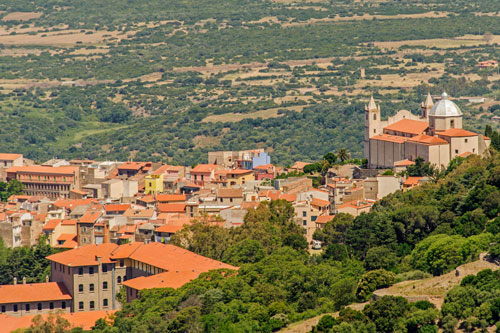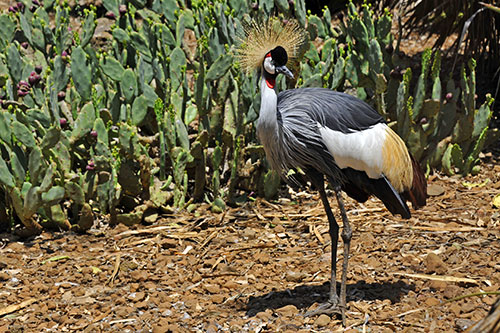Tour in the Montiferru Area
map of the Montiferru Area with the marked sights
Cascata Sos Molinos

This is one of the most beautiful waterfalls in Sardinia. The water cascades down over five steps from a total height of 30 meters into a small pool. Even in the height of summer, the river still flows, offering a refreshing escape in the shaded valley.
However, the waterfall is no longer a hidden gem, and the small parking lot quickly fills up during peak season.
From the parking lot, a steep, approximately 200-meter path leads down into the river valley. The elevation change is 64 meters, and the short hike takes no more than 10 minutes.
How to get there: Follow the SP15 from Santu Lussurgiu towards Bonarcado. About 2 km after leaving Santu Lussurgiu, there is a small parking lot on the left side of the road (about 400 meters after a sharp left turn, see map). A rock here is marked with “Cascata Sos Molinos,” but this is only visible from the opposite direction.
San Leonardo de Siete Fuentes

The small village lies about 7 km north of Santu Lussurgiu.
The few houses are located near the Church of San Leonardo, which dates back to the 12th century and was part of a monastery.
The complex was built by the Knights Hospitaller and included a hospital and accommodations for pilgrims. Unfortunately, none of the monastery’s outbuildings have survived.
Originally built in the Romanesque style, the church is the result of three additional medieval construction phases and several restorations.
San Leonardo de Siete Fuentes is surrounded by beautiful forests with ancient oak and cork trees, offering delightful walking opportunities.
Every first weekend of June, the village hosts Sardinia’s oldest horse market, accompanied by evening folkloric events.

A marked path leads from the church to the springs above the park.
Water flows from several openings in a wall into small channels that wind through the park and collect in a small pond below.
The park offers stone picnic tables in the shade of ancient oaks and poplars, as well as some playground equipment for children.
Beside the main road stands a mineral water company where the spring water is bottled and sold across Sardinia as “Siete Fuentes.”
The mineral water is reputed to have healing properties, particularly for the kidneys and urinary tract.
Casteddu Etzu

The ruins of this fortress are situated on a steep rock west of the SP19 (see map).
The castle was built in 1186 as a border fortification of the Judicate of Torres against the neighboring Judicate of Arborea.
With the Spanish occupation of Sardinia and the decline of the individual judicates, the castle lost its significance. It changed hands a few times before being abandoned in 1670.
Today, only a few remnants of the outer walls and towers and some underground cisterns remain.
The climb is worthwhile mainly for the truly stunning panorama, offering views over the wooded slopes of Montiferru, to Cuglieri, and further to the sea.
The ascent is especially beautiful in spring when the surroundings are a colorful sea of flowers, and the rocks are covered with blue wall pepper blooms.
Cuglieri

The town of Cuglieri has been known since antiquity under the name Gurulis Nova.
The area has a tumultuous history. Down on the coast was the Punic settlement of Cornus, which became the main center of the anti-Roman uprising during the Second Punic War.
Cornus fell to the Romans and had to be abandoned in the Middle Ages due to constant pirate attacks. The inhabitants retreated inland to Gurulis Nova (now Cuglieri).
Cuglieri has been the subject of border disputes, served as a provincial capital, and in 1928, Sardinia’s first malaria colony was established here.
Today, tourists are mainly interested in the Cathedral of Santa Maria della Neve. From the square in front of the church, there are beautiful views over Cuglieri and the surrounding area to the sea.
The cathedral’s interior is lavishly decorated.
Il Parco Degli Uccelli

This bird park is unique in Sardinia.
On about 20,000 square meters, birds from around the world are housed. There are colorful parrots, ostriches, peacocks, cranes, and other exotic birds, as well as species native to Sardinia, such as flamingos.
The park’s primary goal is the preservation and breeding of rare species, but visitors are welcome, as their entrance fees help fund the project.

In addition to birds, other animals native to Sardinia live here.
There are enclosures for land tortoises, Sardinian deer (photo), and a donkey native to Asinara.
Unfortunately, during our visit, the small wild horses of Giara di Gesturi were no longer present. They had not gotten along with the donkey and had to be relocated.
The small park is particularly worthwhile for families with children.
How to get there: The access road is signposted and located on the SP21, about 2 km north of Scano di Montiferru. Here, a narrow, unpaved but passable track leads to the parking lot (see map).
If coming from Scano, follow the signs to Sindia or S. Antioco at the town exit.
Nuraghe Nuracale

The Nuraghe may appear inconspicuous at first glance, but it is the largest fortress in the Montiferru area.
The central tower still stands at a height of 11 meters today and is located in the middle of a square courtyard.
In the ground floor of the tower are the ruins of the upper floor, with two staircases leading to the first floor.
The courtyard is surrounded by a wall with four corner towers.
Excavations have been ongoing in recent years and are far from complete. These have revealed a Nuragic village in the immediate vicinity.
How to get there: The access to the Nuraghe is on the SP21, just 100 meters north of the entrance to the bird park.
There are no parking facilities at the entrance. It is best to leave your vehicle at the bird park and walk here.
Sorgenti di Sant’Antioco

The springs are among the most abundant in Sardinia.
Three religious festivals are celebrated here annually.
The Church of Sant’Antioco was probably built in 1636 and dedicated to Saint Antioco, who was banished to the island of Sulki (the present-day Isola di Sant’Antioco) by Emperor Hadrian.
The park of Sant’Antioco is an excellent place to spend the hot midday hours during your tour.
Tall trees provide plenty of shade, and there are several picnic tables in the park.
Below the church, water flows from the main spring in a broad stream into the Rio Mannu (photo).
A hiking trail is said to lead through the river valley from here, but during our visit, the paths were completely overgrown and hardly suitable for hiking.
The park is well signposted from all directions.
